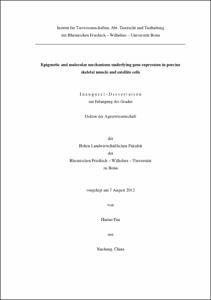Fan, Huitao: Epigenetic and molecular mechanisms underlying gene expression in porcine skeletal muscle and satellite cells. - Bonn, 2012. - Dissertation, Rheinische Friedrich-Wilhelms-Universität Bonn.
Online-Ausgabe in bonndoc: https://nbn-resolving.org/urn:nbn:de:hbz:5n-29992
Online-Ausgabe in bonndoc: https://nbn-resolving.org/urn:nbn:de:hbz:5n-29992
@phdthesis{handle:20.500.11811/5128,
urn: https://nbn-resolving.org/urn:nbn:de:hbz:5n-29992,
author = {{Huitao Fan}},
title = {Epigenetic and molecular mechanisms underlying gene expression in porcine skeletal muscle and satellite cells},
school = {Rheinische Friedrich-Wilhelms-Universität Bonn},
year = 2012,
month = sep,
volume = 162,
note = {Epigenetic studies have been conducted in association with skeletal muscle only during the last years. We performed in vivo study in skeletal muscle and in vitro study in satellite cells with the aims to understand the epigenetic mechanisms regulating muscle gene expression. Duroc and Pietrain pigs, representing two extremes in skeletal muscle phenotypes, were selected for the in vivo study. Myogenic factor 6 (MYF6) was selected as one of the contributing factors to the postnatal breed-specific muscle properties in two breed pigs. Quantitative real time PCR (qRT-PCR) and Western blotting results revealed that mRNA and protein expression of MYF6 were dramatically higher in Pietrain pigs compared to Duroc pigs and suggested breed-specific expression. Variations in DNA methylation of the MYF6 gene 5´-regulatory region, particularly within important transcription factor binding elements, are shown to occur between breeds. However, in Pietrains pigs, higher expression of MYF6 is not consistent with hypermethylation status, but concurrent with enriched E2F1 expression. In addition to its practical implications, this work extends our understanding the role of epigenetic mechanism in postnatal pigs. Satellite cells, acting as the muscle stem cells to support postnatal muscle growth, were selected for the in vitro study. Sulforaphane (SFN), a novel and natural histone deacetylase (HDAC) inhibitor, was selected as the treatment epigenetic reagent. Apart from SFN, we also employed the typical epigenetic reagents 5-aza-2′-deoxycytidine (5-aza-dC) and trichostatin (TSA). Distinguished from TSA, SFN and 5-aza-dC remarkably suppress myostatin (MSTN) expression and inhibit HDAC activity as well as DNA methyltransferase (DNMT) expression. SFN, 5-aza-dC and TSA exhibited differential mechanisms to repress MSTN expression and negative regulators of MSTN pathway. Deregulated miRNA may be excluded from epigenetic repression of MSTN. However, epigenetic suppression of MSTN by 5-aza-dC and SFN is associated with the decreased myoblast determination protein (MyoD) expression, reduced binding of MyoD on MSTN promoter and hypoacetylation in MyoD binding site. These observations manifest a novel mechanism for manipulation of muscle cell phenotypes.},
url = {https://hdl.handle.net/20.500.11811/5128}
}
urn: https://nbn-resolving.org/urn:nbn:de:hbz:5n-29992,
author = {{Huitao Fan}},
title = {Epigenetic and molecular mechanisms underlying gene expression in porcine skeletal muscle and satellite cells},
school = {Rheinische Friedrich-Wilhelms-Universität Bonn},
year = 2012,
month = sep,
volume = 162,
note = {Epigenetic studies have been conducted in association with skeletal muscle only during the last years. We performed in vivo study in skeletal muscle and in vitro study in satellite cells with the aims to understand the epigenetic mechanisms regulating muscle gene expression. Duroc and Pietrain pigs, representing two extremes in skeletal muscle phenotypes, were selected for the in vivo study. Myogenic factor 6 (MYF6) was selected as one of the contributing factors to the postnatal breed-specific muscle properties in two breed pigs. Quantitative real time PCR (qRT-PCR) and Western blotting results revealed that mRNA and protein expression of MYF6 were dramatically higher in Pietrain pigs compared to Duroc pigs and suggested breed-specific expression. Variations in DNA methylation of the MYF6 gene 5´-regulatory region, particularly within important transcription factor binding elements, are shown to occur between breeds. However, in Pietrains pigs, higher expression of MYF6 is not consistent with hypermethylation status, but concurrent with enriched E2F1 expression. In addition to its practical implications, this work extends our understanding the role of epigenetic mechanism in postnatal pigs. Satellite cells, acting as the muscle stem cells to support postnatal muscle growth, were selected for the in vitro study. Sulforaphane (SFN), a novel and natural histone deacetylase (HDAC) inhibitor, was selected as the treatment epigenetic reagent. Apart from SFN, we also employed the typical epigenetic reagents 5-aza-2′-deoxycytidine (5-aza-dC) and trichostatin (TSA). Distinguished from TSA, SFN and 5-aza-dC remarkably suppress myostatin (MSTN) expression and inhibit HDAC activity as well as DNA methyltransferase (DNMT) expression. SFN, 5-aza-dC and TSA exhibited differential mechanisms to repress MSTN expression and negative regulators of MSTN pathway. Deregulated miRNA may be excluded from epigenetic repression of MSTN. However, epigenetic suppression of MSTN by 5-aza-dC and SFN is associated with the decreased myoblast determination protein (MyoD) expression, reduced binding of MyoD on MSTN promoter and hypoacetylation in MyoD binding site. These observations manifest a novel mechanism for manipulation of muscle cell phenotypes.},
url = {https://hdl.handle.net/20.500.11811/5128}
}






